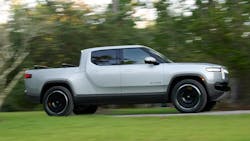Rivian CEO Sees Further Progress Ahead on Cost Cuts
Rivian Automotive’s rocky 2024 continued into the third quarter, but its leaders aren’t flinching and keeping their focus trained on cost efficiencies.
The EV manufacturer booked lower-than-expected revenues of $874 million compared to Q2’s $1.15 billion. Delivery numbers also dropped by more than 3,000 quarter over quarter. The numbers weren’t all bad, however: Operating expenses came in at $777 million, a 16% improvement from the previous quarter even as the company produced 13,157 vehicles compared to 9,612 in Q2.
Most of Rivian’s trouble can be tied back to one main issue: A component shortage. Last month, Rivian reduced its production guidance by roughly 10,000 vehicles due to a shortage of a part needed for its R1 and EDV platforms— a mistake of its own making stemming from a miscommunication to the part’s supplier. CFO Claire McDonough on Nov. 7 reaffirmed the new range, 47,000 to 49,000 vehicles, and emphasized that executives considered the shortage a “short-term obstacle.”
In fact, they already have a workaround: a new powertrain called the Tri-Motor, a variant that offers better performance at a lower cost, needs fewer parts and can be produced amidst the shortage. The new powertrain is part of the progress Rivian has made in its cost-cutting measures.
“Importantly, in the third quarter, we saw a meaningful reduction in our second generation R1 material cost as compared to our first-generation. This is in-line with our target, and we expect to see this continue into the fourth quarter,” CEO RJ Scaringe said.
Cost reduction is also top of mind for Rivian’s upcoming R2 SUV, which Scaringe affirmed is expected to have a starting price of $45,000, nearly half of its flagship R1’s $70,000 price tag. While the R2 won’t launch until 2026 at the earliest, sourcing for its production is roughly 85% complete, he said, and all within the “aggressive cost targets” leaders set for the program.
But there’s a catch: Making sure production lines are ready. The R2 was originally set to be produced at Rivian’s new plant in Georgia but construction at that site was paused earlier this year as leaders looked to save money. Instead, the vehicle will be produced at Rivian’s plant in Normal, Illinois, which was temporarily shut down this spring to retool the lines for the second-generation R1 and upcoming R2.
McDonough mentioned that Rivian teams are planning another shutdown in the second half of 2025 to ensure everything is ready for the R2 launch. Alongside the spring retooling, the Normal plant will also get a massive expansion that includes a 1.14 million square-foot R2 building and a conveyor system connecting the old and new facilities.
Scaringe said the expansions were “well underway,” with most of the grading work complete.
In the shorter term, Rivian executives are sticking to their 2024 delivery outlook of 50,500 to 52,000 vehicles and a “modest” GAAP gross profit in Q4 due to a higher average R1 sales price and a lower fixed cost per vehicle. Rivian lost $39,130 per car in the third quarter, a 20% jump from Q2.
Lowered production volumes mean Scaringe and his team had to revise Rivian’s annual adjusted EBITDA guidance by nearly $2 million to a loss between $2.825 billion and $2.875 billion. They still expect CapEx to come in at $1.2 billion.
Shares of Rivian (Ticker: RIVN) rose slightly Nov. 8 after the earnings report. They have fluctuated over the past six months, leaving the company’s market capitalization at about $10.3 billion.
